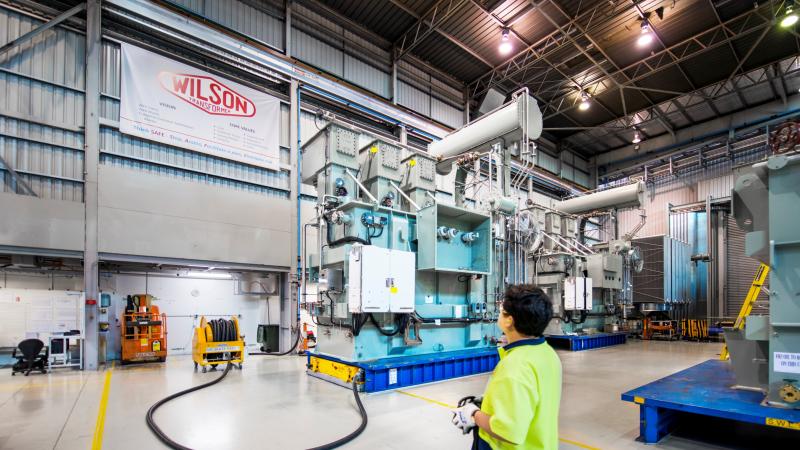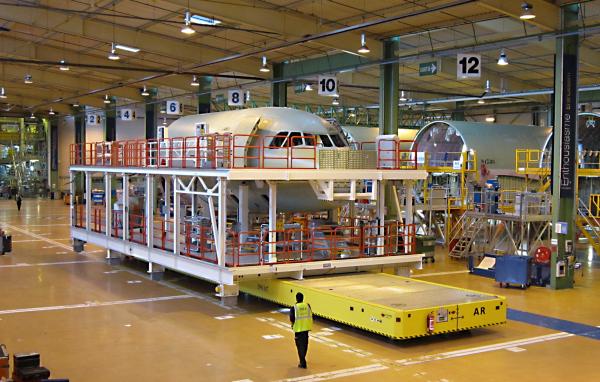28.04.2021
Making the choice between Solving’s Air Film Movers and Wheeled Movers

Solving designs and manufactures customised material handling systems, supported either on air bearings (otherwise known as air film technology) wheels or and both alternatives have their advantages. Although there is no specific rule to enable the customer to choose one or the other, certain factors are taken into account when determining the most appropriate solution to a material handling requirement. In this article we describe the pros and cons of each system and give an insight into the process of making the right choice.
Some basic features are common to both types of Mover; for example, the structural frames for both systems are rigidly constructed from welded mild steel to cope with large loads and a typically heavy industrial manufacturing environment, and our Movers incorporate all the necessary personnel safety devices. These also ensure that collisions and consequent damage to the load or surroundings are avoided.
Load capacities
Air film transporters are a cost-effective solution for loads weighing from a few thousand kilograms up to 1000 tons or more. There are not many other floor-based solutions with the same kind of capacities.
Solving Wheeled transporters are generally suitable for 100-150 ton loads, even though higher capacities are possible.
Precise positioning and omnidirectional driving
Air film transporters are omnidirectional. Heavy loads can be positioned with millimeter precision and operated in any horizontal direction. This means that air film transporters are very appropriate in narrow areas.
Wheeled transporters can also be omnidirectional, but they are more expensive and require a higher construction than other wheel configurations. Therefore more common wheel configurations are SD (SteerDrive) and differential wheel configurations. SD uses a pair of rigid wheels carrying the load and a swivel wheel also functioning as a drive wheel. Differential wheel configuration uses two rigid (non-swivel) opposite drive wheels in combination with load carrying wheels.
Point load and floor wear
The point load applied by the air bearings is very low, because the load is spread over a large area with air bearings. There is no friction and thus no floor wear because the air film transporters and load are floated on a film of air.
The point load of wheeled transporters depends on the number and type of wheels. An increased number of wheels and solid rubber wheels instead of traditional polyurethane wheels can be chosen to reduce the point load, although not as low as for air bearing transporters.

Dimensions of equipment
The low lifting height of the air bearings in combination with a low-built air film transporter means that the total height of the handling equipment is very low. For certain types of loads to be moved, such as large transformers, the height of the transport system can be critical, for instance if the clearance between the top of the load to be transported and the door opening is about centimeters.
A wheeled transporter with the same load carrying capacity is larger or higher compared to an air film transporter due to the size of the wheels.
Flexibility of the transport route
Both air film transporters and wheeled transporters are applicable if the transport route must be changed often. There is no need for fixed installations in the floor, which makes the route easy to change.
Easy manoeuvrability of bulky loads
Air film transporters and wheeled transporters are mostly controlled either with a remote-control unit or automatically. A control unit gives the operator freedom to move around the load to be transported and thus safely supervise the transport of bulky loads.
Transport frequency and distance
Whenever the requirement is to handle a heavy load over shorter distances, an air film transporter is a good choice. Automated guided vehicles on air bearings can be applied for even 24h operation when air is supplied through an overhead air transfer system.
Wheeled transporters receive their power supply from onboard batteries, and are therefore completely independent of hoses and cables, and thus suitable both for more frequent transports over extended distances.

Floor quality
Air film transporters provide a clean and safe working environment, because the transport area must be kept rather clean to avoid that any particles get in under the transporter. Certain floor qualities must apply for efficient operation of air film transporters; the most important qualities of an ideal floor are flatness, free of steps, airtight (nonporous) and a paper-smooth surface. A well-trowelled hard concrete surface or a normal vacuum concrete surface ground to paper-smooth and painted are examples of acceptable floor surfaces.
Variations in the floor quality is not so critical for wheels, and thus Solving wheeled transporters can run over varying floor surfaces. Furthermore, the self-levelling axles ensure that the wheels are always evenly loaded and always in contact with the floor.
Indoor / outdoor use
Air film transporters are mainly suitable for indoor use.
Wheeled transporters can be used both indoors and outdoors.
Please contact our sales team for more information.